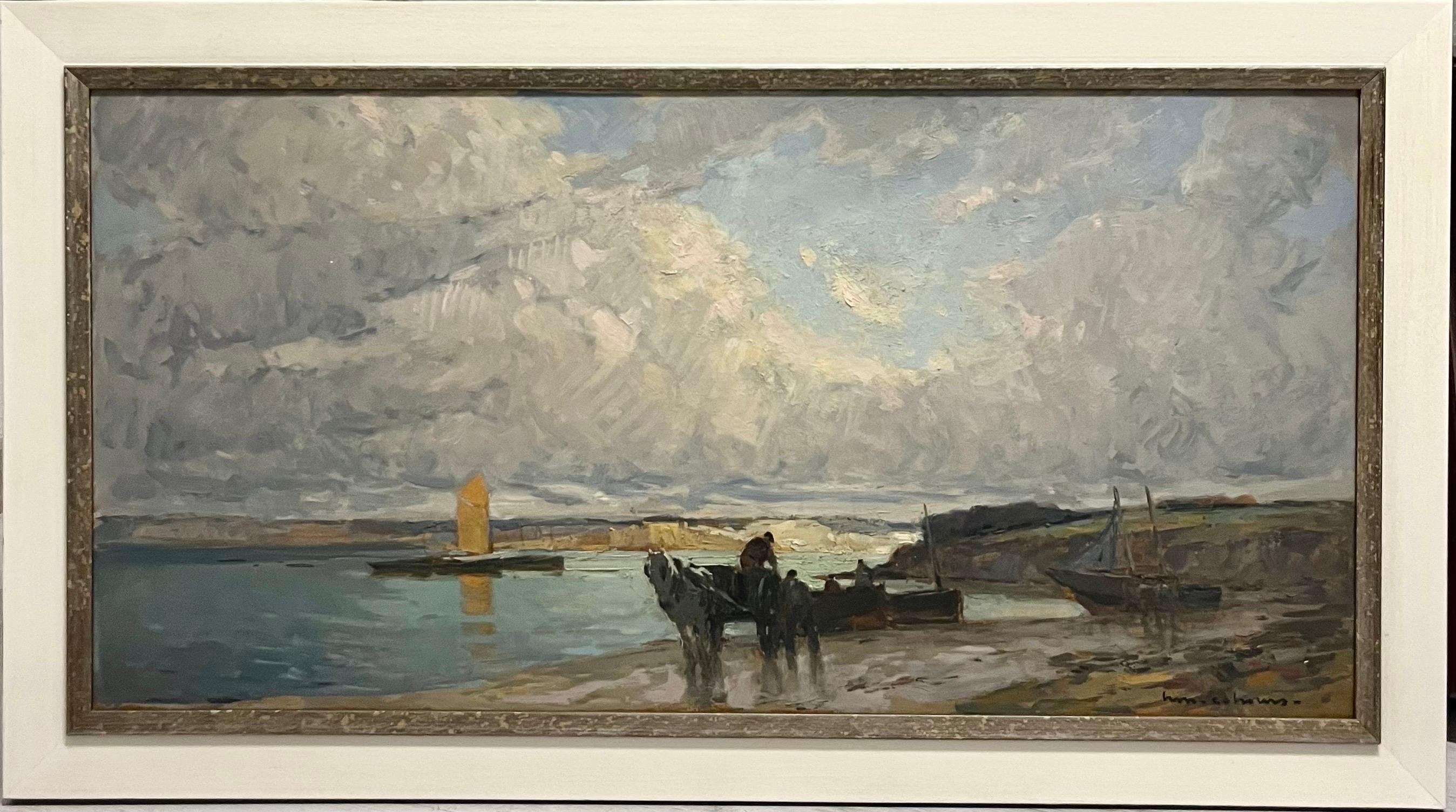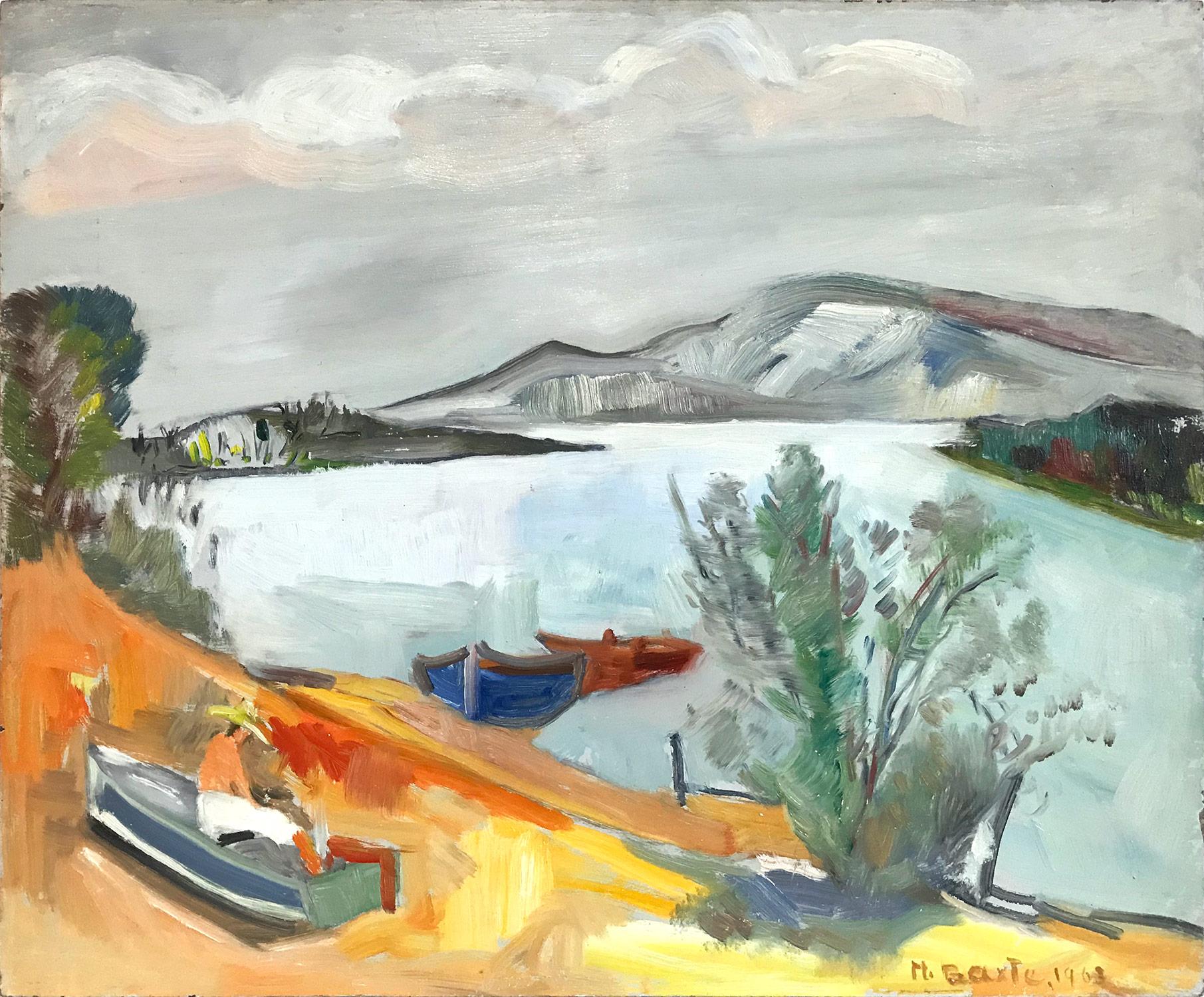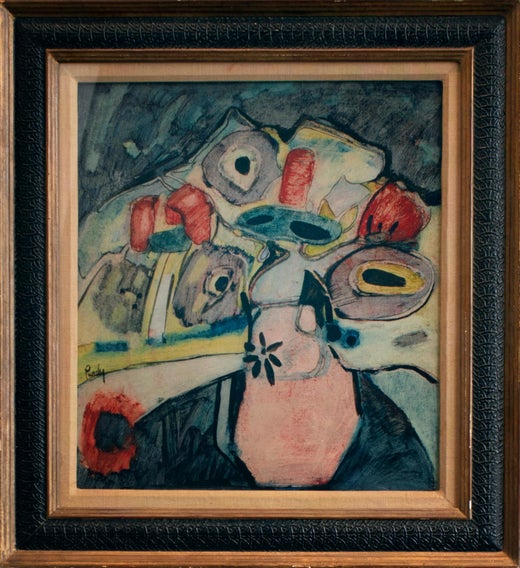Items Similar to Many Umbrellas, Impressionist beach scene
Video Loading
Want more images or videos?
Request additional images or videos from the seller
Donald Roy PurdyMany Umbrellas, Impressionist beach scene1991
1991
About the Item
This marvelous, colorful and light filled work is a desirable work by the painter. It is in an impressionist style carved and leafed frame. Illustrated in the book by the artist "A Life's Work, Donald Purdy".
- Creator:Donald Roy Purdy (1924, American)
- Creation Year:1991
- Dimensions:Height: 18 in (45.72 cm)Width: 22 in (55.88 cm)
- Medium:
- Period:
- Condition:Frame has imperfections to the finish, some wear and touch ups most of which are pictured.
- Gallery Location:Greenwich, CT
- Reference Number:1stDibs: LU141329374522
Donald Roy Purdy
Self-taught, Purdy was influenced by many artists, including the Barbizon School, French Impressionists and Post-Impressionists, and American 19th Century Painters. No particular artistic influence was evident during his childhood. After high school, he enlisted in the army air force and entered Germany as a foot soldier with the 9th army. After the war, Purdy pursued a degree in Psychology, graduating in 1949 from the University of Connecticut and from Boston University with his Master’s in Psychology in 1950. While in Boston, Purdy worked in an art gallery, performing tasks such as framing pictures. It was here that he first became art-conscious and was surprised to learn that individuals actually chose art as a profession. Purdy lived and painted most of his life in New England. He exhibited extensively throughout the U.S. and Europe, including: The Britain Museum, Connecticut; The Butler Institute, Columbus, Ohio; Colby College, Maine; The University of Kansas; The Chrysler Collection; and Bernheim-Jeune Galleries, Paris. In addition, he has been honored with numerous awards including a Gold Medal from the Allied Artists. He was a teacher of painting at the Silvermine Academy of Art in Connecticut and is listed in Who’s Who in American Art.
About the Seller
5.0
Gold Seller
These expertly vetted sellers are highly rated and consistently exceed customer expectations.
Established in 1857
1stDibs seller since 2020
34 sales on 1stDibs
Typical response time: 1 hour
- ShippingRetrieving quote...Ships From: Port Chester, NY
- Return PolicyA return for this item may be initiated within 14 days of delivery.
More From This SellerView All
- Halleluja, A storyLocated in Greenwich, CTInitially read as archaic and simple, Halleluja is a complex celebratory spring painting full of color, imagination, and humor and combines many elements seen throughout her later ca...Category
1940s American Modern Figurative Paintings
MaterialsOil, Canvas
- Palazzo DarioBy Warren W. SheppardLocated in Greenwich, CTA classic and elegant Venetian view with a period Barbizon, gold leaf frame! Sheppard did a series of these and two other American painter is more noted for their Venetian views than...Category
1860s Realist Figurative Paintings
MaterialsOil
- Les Plaisirs de la Riverie, regatta boatingLocated in Greenwich, CTA classic French subject that would enliven any room. Beautifully painted and the colors are restrained which make it elegant. A noted artist and a rare subject especially with the...Category
1920s Impressionist Landscape Paintings
MaterialsOil, Canvas
- Mother and ChildLocated in Greenwich, CTAn exceptional watercolor in terms of quality and presentation. During this earlier period of Day's career he exhibited extensively and was inspired by Victorian and Pre-Raphaelite ...Category
1910s Pre-Raphaelite Figurative Paintings
MaterialsWatercolor
- The Breakfast RoomLocated in Greenwich, CTA great early date for this artist where he was coming out of the origins of expressionist and fauve works of art. A unique composition depicting a woman setting out a table laden w...Category
1960s Expressionist Figurative Paintings
MaterialsOil, Masonite
- Omnibus sur le Boulevard Saint Denis, Soir deBy Édouard Leon CortèsLocated in Greenwich, CTOmnibus sur le Boulevard Saint Denis is a great and classic Cortes that depicts this favorite spot where he loved to paint many of his compositions, in the dark of night. Cortes lov...Category
1910s French School Figurative Paintings
MaterialsOil, Canvas
You May Also Like
- "Paysage du Nord de la France " Bretagne, Oil cm. 100 x 50 Offer Free ShippingBy Henry Maurice CAHOURSLocated in Torino, ITSailboat,Sea,France,Port,Boat ,Landscape ,Britain , Atlantic Ocean, Blu , Grey . Label on the back Galleria Pirra Torino This work is more than 50 year...Category
1930s Post-Impressionist Landscape Paintings
MaterialsOil, Masonite
- Trastevere FountainLocated in Milford, NHA nice impressionist oil on masonite city scene with a young crowd in Rome, Italy, probably the Fontana del Prigione, illegibly signed lower right, title inscribed on verso “Trastev...Category
1950s Impressionist Figurative Paintings
MaterialsOil, Masonite
- "Summer at the Lake" - Mid Century Figurative LandscapeBy Grace B. OlsonLocated in Soquel, CAMid-century figurative landscape painting of people enjoying the summertime at a rustic cabin near a mountain lake by Santa Cruz, California artist Grace B. Olson (American, 1889-198...Category
1960s American Impressionist Landscape Paintings
MaterialsMasonite, Oil
- "Landscape Scene of Mexican Villagers" Expressionistic Oil Painting on MasoniteBy Michael BaxteLocated in New York, NYA strong modernist oil painting depicted in 1971 by Russian painter Michael Baxte. Mostly known for his abstracted figures on canvas or street scenes, this piece is a wonderful representation of his landscape paintings, with expressive use of color, shape, and form. Later in his career, Baxte explores Expressionism, infusing both European and North American stylistic trends. This piece is from later in his career, but we can feel this underlying style throughout. Art measures 18 x 21.75 inches Michael Posner Baxte was born in 1890 in the small town of Staroselje Belarus, Russia. For the first half of the 19th century it was a center of the Chabad movement of Hasidic Jews, but this group was gone by the middle of the 19th century. By the time the Baxte family immigrated to the United States at the beginning of the 20th century, the Jewish population numbered only on the hundreds. The native language of the Baxte family was Yiddish. It is likely that the death of Michael Baxte’s father triggered the family’s immigration. Three older brothers arrived in New York between 1903 and 1905. Michael and his mother, Rebecca, arrived in 1907. By 1910 Michael, his mother, and brother, Joseph, were living in New Orleans and may have spent some time on a Louisiana plantation. Around 1912, Michael Baxte returned to Europe to study the violin. In 1914 he, his mother, and Joseph moved to New York City. Meanwhile, in Algeria, a talented young woman painter, Violette Mege, was making history. Since for the first time, a woman won the prestigious Beaux Art competition in Algeria. At first, the awards committee denied her the prize but, with French government intervention, Mege eventually prevailed. She won again 3 years later and, in 1916, used the scholarship to visit the United States of America. When Violette came to New York, she met Baxte, who was, by then, an accomplished violinist, teacher, and composer. Baxte’s compositions were performed at the Tokyo Imperial Theater, and in 1922 he was listed in the American Jewish Yearbook as one of the prominent members of the American Jewish community. As a music teacher he encouraged individual expression. Baxte stated, “No pupil should ever be forced into imitation of the teacher. Art is a personal experience, and the teacher’s truest aim must be to awaken this light of personality through the patient light of science.” By 1920 Michael Baxte and Violette Mege were living together in Manhattan. Although they claimed to be living as husband and wife, it seems that their marriage did not become official until 1928. On their “unofficial” honeymoon around 1917, in Algiers, Baxte confided to her his ambition to paint. There and later in New Mexico where the wonderful steeped sunlight approximates the coloring of Algiers, she taught him his heart’s desire. He never had any other teacher. She never had any other pupil. For ten years she devoted all her time, energy, and ambition to teaching, encouraging, inspiring him. Then in 1928, their mutual strivings were rewarded, as his works were being chosen as one of the two winners in the Dudensing National Competition for American Painters. Out of 150 artists from across the country participated in the Dudensing, and Michael Posner Baxte and, Robert Fawcett, were the winners. In his 1924 naturalization application, he indicated that he was sometimes known as “Michael Posner Baxte.” One of the witnesses to his application was Bernard Karfiol, a Jewish American artist. That’s when Michael may...Category
1960s Expressionist Landscape Paintings
MaterialsMasonite, Oil
- "Landscape Scene of Fisherman by Lake" Expressionistic Oil Painting on MasoniteBy Michael BaxteLocated in New York, NYA strong modernist oil painting depicted in 1963 by Russian painter Michael Baxte. Mostly known for his abstracted figures on canvas or street scenes, this piece is a wonderful representation of his figures in water landscapes with expressive use of color, shape, and form. Later in his career, Baxte explores Expressionism, infusing both European and North American stylistic trends. This piece is from later in his career, but we can feel this underlying style throughout. Art measures 18 x 21.75 inches Michael Posner Baxte was born in 1890 in the small town of Staroselje Belarus, Russia. For the first half of the 19th century it was a center of the Chabad movement of Hasidic Jews, but this group was gone by the middle of the 19th century. By the time the Baxte family immigrated to the United States at the beginning of the 20th century, the Jewish population numbered only on the hundreds. The native language of the Baxte family was Yiddish. It is likely that the death of Michael Baxte’s father triggered the family’s immigration. Three older brothers arrived in New York between 1903 and 1905. Michael and his mother, Rebecca, arrived in 1907. By 1910 Michael, his mother, and brother, Joseph, were living in New Orleans and may have spent some time on a Louisiana plantation. Around 1912, Michael Baxte returned to Europe to study the violin. In 1914 he, his mother, and Joseph moved to New York City. Meanwhile, in Algeria, a talented young woman painter, Violette Mege, was making history. Since for the first time, a woman won the prestigious Beaux Art competition in Algeria. At first, the awards committee denied her the prize but, with French government intervention, Mege eventually prevailed. She won again 3 years later and, in 1916, used the scholarship to visit the United States of America. When Violette came to New York, she met Baxte, who was, by then, an accomplished violinist, teacher, and composer. Baxte’s compositions were performed at the Tokyo Imperial Theater, and in 1922 he was listed in the American Jewish Yearbook as one of the prominent members of the American Jewish community. As a music teacher he encouraged individual expression. Baxte stated, “No pupil should ever be forced into imitation of the teacher. Art is a personal experience, and the teacher’s truest aim must be to awaken this light of personality through the patient light of science.” By 1920 Michael Baxte and Violette Mege were living together in Manhattan. Although they claimed to be living as husband and wife, it seems that their marriage did not become official until 1928. On their “unofficial” honeymoon around 1917, in Algiers, Baxte confided to her his ambition to paint. There and later in New Mexico where the wonderful steeped sunlight approximates the coloring of Algiers, she taught him his heart’s desire. He never had any other teacher. She never had any other pupil. For ten years she devoted all her time, energy, and ambition to teaching, encouraging, inspiring him. Then in 1928, their mutual strivings were rewarded, as his works were being chosen as one of the two winners in the Dudensing National Competition for American Painters. Out of 150 artists from across the country participated in the Dudensing, and Michael Posner Baxte and, Robert Fawcett, were the winners. In his 1924 naturalization application, he indicated that he was sometimes known as “Michael Posner Baxte.” One of the witnesses to his application was Bernard Karfiol, a Jewish American artist. That’s when Michael may...Category
1960s Expressionist Landscape Paintings
MaterialsMasonite, Oil
- 1940s Southwestern Figurative Landscape -- Pueblo Village New MexicoBy William FratesLocated in Soquel, CAGorgeous 1940s New Mexico village scene with small figures going about daily life among adobe buildings that are iconic of the Southwest, by William “Will” Frates (American, 1896-1969). Signed "Will FRATES" in the lower right corner. Titled "New Mexico Village" and Will Frates" on verso in pencil. Unframed. Image size: 24"H x 29.5"W. William Frates...Category
1940s American Impressionist Landscape Paintings
MaterialsOil, Fiberboard, Masonite





